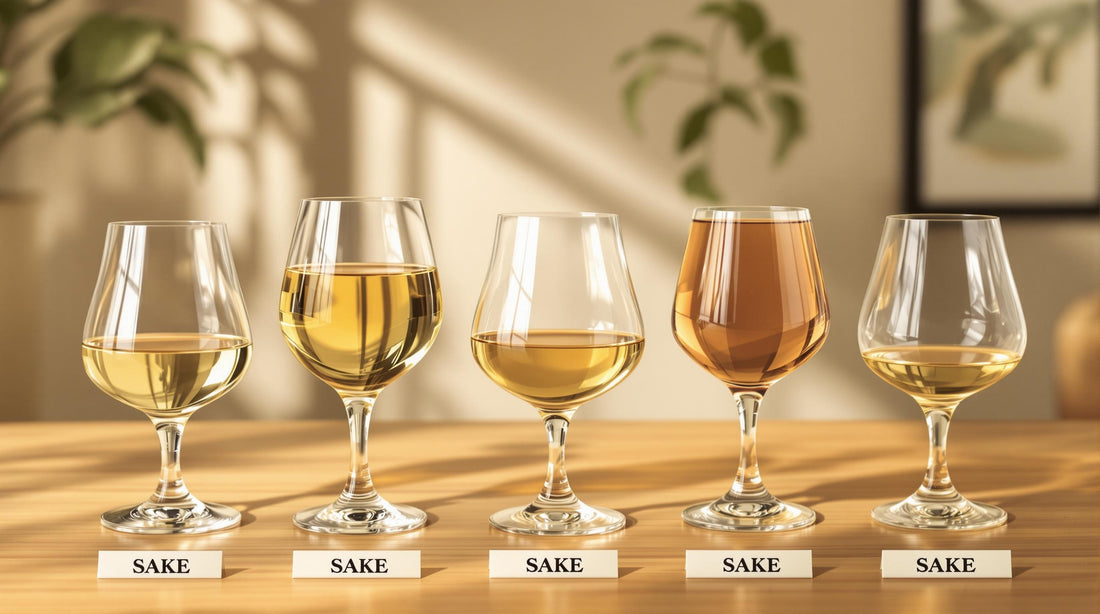
Ultimate Guide to Sake Glass Shapes
Share
The shape of your sake glass can change how it tastes, smells, and feels. Here's a quick breakdown to help you pick the perfect glass for any sake:
- Wide rims: Great for warm sake, spreading heat and aroma evenly.
- Narrow rims: Best for chilled sake, focusing delicate flavors and keeping it cold.
- Trumpet-shaped glasses: Highlight aromatic sakes.
- Bowl-shaped glasses: Bring out umami-rich flavors.
- Ceramic cups: Retain heat for warm sake.
- Crystal glasses: Ideal for chilled varieties, keeping flavors pure.
Different glass shapes are suited to specific sake types and temperatures. Whether you’re enjoying sparkling sake, umami-rich junmai, or aromatic ginjo, the right glass makes a big difference. Let’s explore how to elevate your sake experience with the right glassware!
Classic Japanese Sake Vessels
Traditional Japanese sake vessels are not just functional; they also carry a deep connection to Japan's heritage and enhance the sake-drinking experience.
Ochoko: Small Cylinder Cups
Ochoko cups, holding just 1-2 ounces, are designed to bring out the intricate flavors of sake. Their narrow, cylindrical shape is especially effective for richer sake varieties, as it highlights umami notes when tilted during sipping [1].
| Feature | Purpose |
|---|---|
| Small Size | Keeps sake at the right temperature |
| Cylindrical Shape | Intensifies flavor concentration |
| Narrow Design | Improves aroma delivery |
Sakazuki: Shallow Sake Saucers
Sakazuki cups are tied to formal and ceremonial occasions, such as weddings and other traditional events. These shallow, wide-rimmed saucers are designed to release sake’s aroma and distribute it evenly across the palate [1][2].
"The shape of the sakazuki cup releases more of the aroma of the sake, and helps spread the sake to the corners of your lips." - Tippsy Sake [2]
Masu: Square Wooden Cups
Masu cups, originally used for measuring rice during the Edo period, now add a unique touch to sake drinking. Made from cedar wood, these square vessels subtly infuse sake with earthy, woody notes while keeping the temperature steady. Their tactile feel adds another layer to the experience [3].
Each vessel has its strengths: ochoko pairs well with rich junshu sakes, sakazuki enhances aromatic varieties, and masu adds a rustic charm. While these traditional designs honor Japan's sake heritage, modern glassware offers new ways to enjoy sake, building on these classic foundations.
Current Glass Styles for Sake
Today's sake glass designs combine Japanese tradition with modern wine glass features to elevate the drinking experience. These glasses are crafted to suit various sake types while preserving ideal temperatures and enhancing aromas.
Wine Glasses for Sake
Wine glasses, known for their wide bowls and narrow rims, are excellent for bringing out the best in sake. They enhance aromas and allow flavors to fully develop, making them particularly suited for bold, umami-rich sakes [1].
| Glass Feature | How It Benefits Sake |
|---|---|
| Wide Bowl | Lets sake breathe and enhances flavor complexity |
| Narrow Rim | Focuses and intensifies aromas |
| Long Stem | Keeps hand warmth from altering the temperature |
| Crystal Material | Ensures a neutral taste experience |
Tulip and Flute Glasses
Tulip and flute glasses are perfect for sparkling sake. Their tall, slender shape helps retain carbonation and directs subtle aromas, making them ideal for showcasing the delicate qualities of premium sparkling varieties [1][2].
Stemless Glass Options
For a more casual and practical choice, stemless glasses are a great option. While they don't concentrate aromas as much, they are convenient and versatile for everyday use [1].
When choosing stemless glasses, look for ones with a wide enough bowl to allow proper aeration, ensuring the sake's flavors can fully develop [2]. The material of the glass also matters, as it can influence how the sake's natural characteristics are experienced.
Modern sake glassware highlights how contemporary designs can complement traditional sake drinking. Each style serves a unique purpose, whether it's enhancing premium flavors or offering practical solutions for informal settings. Understanding these options helps you pick the right glass for any sake type or occasion.
Selecting Sake Glasses by Type
Glass Shapes for Different Temperatures
The temperature of sake has a big impact on how it tastes, so choosing the right glass is key to enjoying it fully. For chilled sake, narrow-rimmed glasses help keep it cold while focusing its delicate flavors [1]. On the other hand, sake served at room temperature benefits from glasses with slightly wider rims, which allow the aromas to develop more naturally.
When it comes to warm sake, wider-rimmed glasses are your best bet. They help distribute heat evenly and enhance the aroma [2]. Ceramic vessels are also great for warm sake because they retain heat well, while crystal or glass options are better suited for chilled varieties.
| Temperature | Recommended Glass | Key Benefits |
|---|---|---|
| Chilled (5-10°C) | Narrow-rimmed glasses | Maintains cold temperature, focuses flavors |
| Room temp (15-20°C) | Standard/wider rim | Enhances aroma and flavor balance |
| Warm (35-40°C) | Wide rim | Distributes heat evenly, boosts aroma |
The type of sake you're drinking is just as important as the temperature when selecting the perfect glass.
Glasses for Each Sake Style
Different sake styles shine best in specific glass shapes. For lighter sake, tulip or flute glasses are ideal, as they preserve subtle aromatics [1]. Meanwhile, full-bodied sake benefits from glasses with wider bowls, which let its complex flavors unfold.
Sparkling sake calls for champagne flutes to maintain its carbonation and direct the bubbles upward. If you're enjoying aged sake, narrow-rimmed glasses help concentrate its layered and nuanced flavors [2].
The design of the glass doesn't just affect taste - it also plays a big role in how sake looks and smells.
Aroma and Appearance Factors
The right glass enhances not only the flavor but also the aroma and visual appeal of sake. Narrow rims are perfect for lighter styles, as they focus the aromas, while wider rims allow bold aromas to spread, making them ideal for richer, more complex varieties [1].
The shape of the bowl also matters. Glasses with bowl-shaped designs work well with strong umami flavors and richer tastes, while straight-shaped glasses are better for clean, easy-drinking sake that doesn't need much aeration.
For professional tasters, janome cups with their blue bullseye pattern are the go-to option. They help assess the clarity and color of sake [2]. These design details show how the right glass can elevate both the sensory and aesthetic experience of drinking sake.
sbb-itb-d9fb1bc
Maintaining Sake Glasses
Cleaning Sake Glasses
Taking care of your sake glasses starts with proper cleaning. The best approach? Hand washing. Use mild soap and warm water to gently clean the glass without risking damage. Dishwashers are a no-go - high heat and strong detergents can harm the surface and even cause breakage.
Pottery sake cups need extra care because they can absorb odors and stains. Wash them right after use to avoid lingering smells or discoloration. A traditional Japanese method called "Medome" can help. Boil the cups with rice grains or bran for about 20-30 minutes to seal their porous surface and protect them.
For delicate designs, use a soft cloth during cleaning to avoid scratches or wear. Whether glass or pottery, a little extra attention goes a long way in keeping your sakeware in top shape.
Storing Sake Glasses
Once clean, how you store your sake glasses is just as important. A cool, dry spot with around 70% humidity is ideal to prevent damage and keep them ready for use.
Here are some tips for proper storage:
- Store glasses upright to avoid trapped moisture.
- Wrap delicate pieces in a soft cloth or use protective cases.
- Keep them out of direct sunlight.
- Maintain a storage temperature of 10-15°C.
For specialty or decorated glasses, individual storage compartments or protective sleeves are a smart choice to avoid scratches or accidental damage. A little care in storage ensures your sake glasses stay pristine and ready to elevate your drinking experience.
Conclusion: Choosing the Right Glass
The right sake glass can elevate the aroma, flavor, and overall experience of your drink. Knowing how the shape of a glass impacts temperature, aroma, and flavor distribution helps you pair the perfect glass with your sake.
Here are a few key tips:
- Wide rims work well for warm sake, while narrow rims help maintain the chill of cold sake.
- Trumpet-shaped glasses highlight aromatic sakes, while bowl-shaped glasses suit umami-rich options.
- Match the complexity of your sake to the glass: rich, umami-forward sakes shine in wide-rimmed glasses, whereas delicate sakes benefit from narrow openings that focus their subtleties.
To truly enjoy sake, think about how the glass complements its style. Light, aromatic sakes need vessels that enhance their delicate notes, while more complex sakes benefit from glasses that allow their flavors to fully unfold.
The Sake Company Resources

The Sake Company provides tools to deepen your sake appreciation, including discovery boxes, a sake guide, and insights into how glassware shapes the experience. Their resources allow you to experiment with different glass and sake pairings, helping you refine your preferences.
FAQs
Why are sake cups shaped like that?
Sake cups are designed to enhance the drinking experience by focusing on aroma, flavor, and temperature. Traditional cups like sakazuki, ochoko, and guinomi cater to different sake styles and occasions, each with a specific purpose in mind [1][2].
Here’s a quick guide to common sake cup shapes and their uses:
- Sakazuki: These flat, shallow cups are often used in ceremonial settings and special celebrations.
- Ochoko: Small and cylindrical, these are great for everyday sake drinking.
- Guinomi: Larger with a wider rim, they work well for more complex sake varieties.
While modern glassware can work for sake, traditional cups remain popular for their thoughtful design and ability to complement specific sake characteristics [1][2]. Choosing the right cup can make a big difference in how you enjoy your sake.
